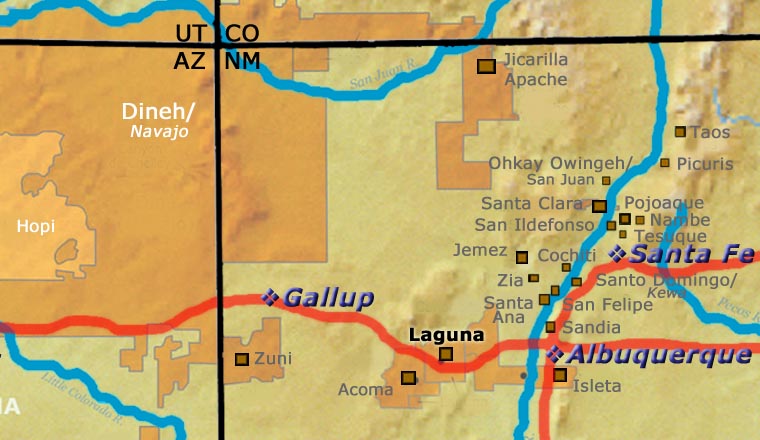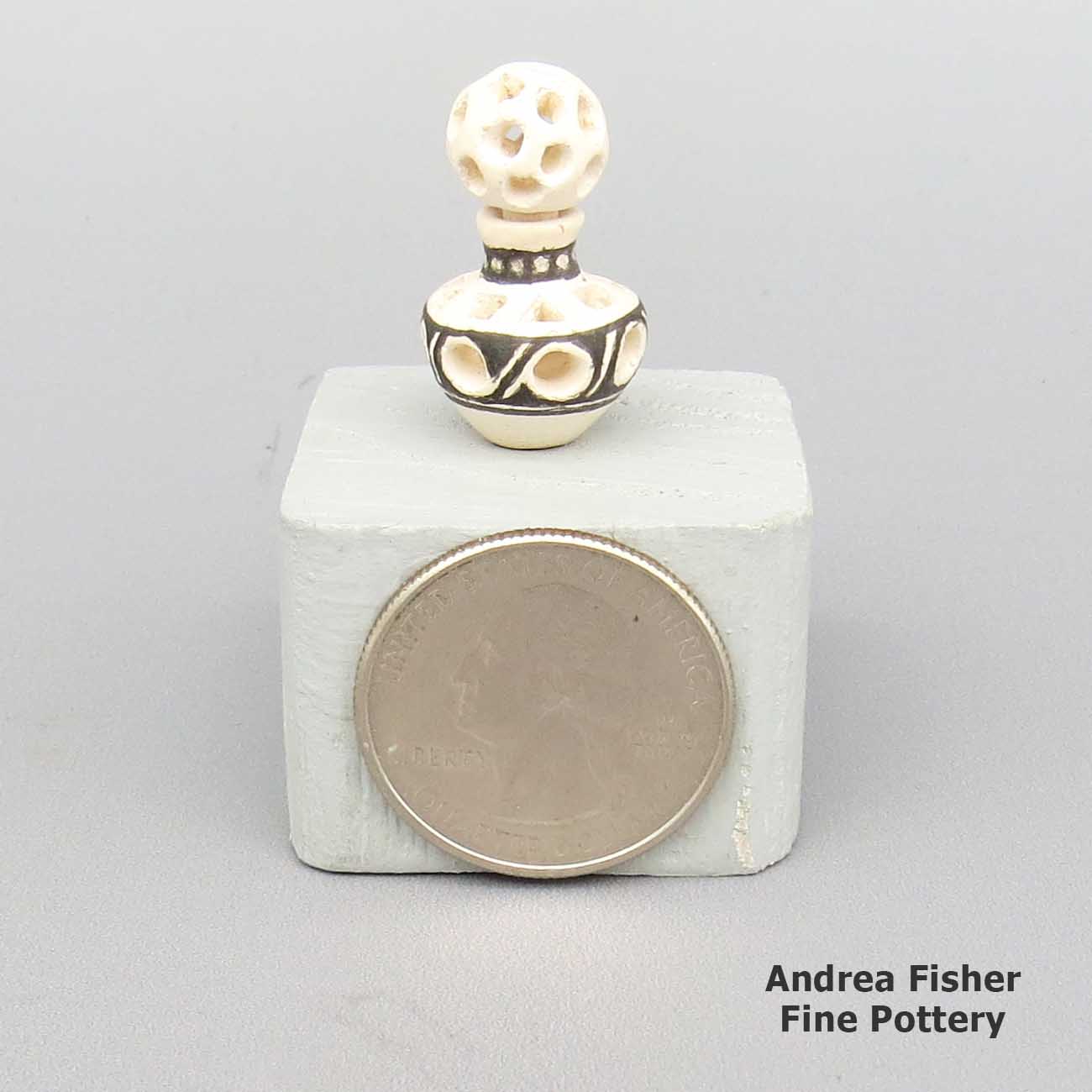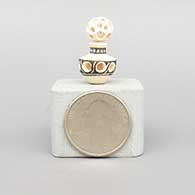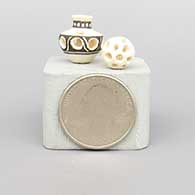
Thomas Natseway
Laguna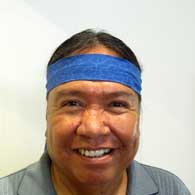
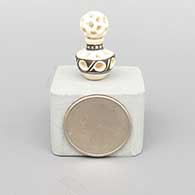
Thomas Natseway was born to Betty and Pete Natseway of Laguna Pueblo in April, 1953. He didn't know much about making pottery until he met his wife, Charmae Shields. Thomas was working as a journalist back then and was assigned to do an interview with Charmae. The meeting was fateful: it sparked a lifelong love. After they were married he began an in-depth course in learning the traditional art from his wife and her mother, Ethel Shields.
Today, Thomas says "I love my work, especially miniatures. I love the challenge of making miniatures." He says he used to participate "in all the shows, but not any more." These days he says the Heard Museum show and the Santa Fe Indian Market are enough for him.
Some of his pieces are in the permanent collections of the Denver Art Museum, Albuquerque Art Museum, San Diego Museum of Man, the University of Nebraska Art Museum and the Smithsonian Institute in Washington, DC.
Thomas tells us his favorite pots to make are miniature reproductions of ancient Laguna pots. He has a very large collection of "hard cover pottery books" and is always looking through them for new ideas. He also likes to visit museums and delve into local archives.
It's hard to get Thomas to talk about himself. His wife Charmae says "Thomas is just like Gentle Ben. He loves his family, his nieces and nephews" and "he gives, very kind-hearted, sacrifices for his family."
Some of Thomas' Recent Awards
- 2023 Santa Fe Indian Market, Pottery Classification F: Category 1001 - Traditional miniatures, Second Place
- 2023 Santa Fe Indian Market, Pottery Classification F: Category 1003 - Miniature figures, including sets, First Place
100 West San Francisco Street, Santa Fe, New Mexico 87501
(505) 986-1234 - www.andreafisherpottery.com - All Rights Reserved

Laguna Pueblo
After the Pueblo Revolt of 1680, many Puebloans were fearful of Spanish reprisals. Spanish militias returned in 1681 and again in 1689. That first return brought them as far north as Isleta and that pueblo was attacked, looted and burned. The second return saw troops marching up to Santa Ana and San Felipe, attacking, looting and burning both. In those years, when the Puebloans became aware of approaching Spanish forces they mostly scattered into the mountains and the Spanish found empty pueblos, easy to loot and easy to burn. When Don Diego de Vargas marched north in 1692, he was intent on reconquering Nuevo Mexico and re-establishing a long-term Spanish presence there. As the conquistadors who accompanied him were on a "do-or-die" mission, the reconquest took on a tenor quite different from the previous missions...
At first de Vargas followed a path of reconciliation with the pueblos but that was soon replaced with an iron fist that brought on a second revolt in 1696. The pueblos didn't fare so well the second time around and a large number of Pueblo warriors were executed while their wives and children were forced into slavery. When word of de Vargas actions got back to the King of Spain, he ordered de Vargas banned from the New World. However, most of the damage was already done.
Many modern historians say Laguna Pueblo was established between 1697 and 1699 by refugees seeking to avoid fighting with the Spanish. Many of those refugees had left the first pueblos approached by the Spanish in 1692. They had first scattered to more remote places like Acoma, Zuni and Hopi, or to more Spanish-friendly Isleta. However, the pressure of those refugees strained the resources of the other pueblos and quickly forced the refugees to consider starting a new existence in a newly-formed pueblo. The area of Laguna had been settled several hundred years previously by ancestors of today's tribe but had been abandoned during the periods of great drought that had brought the Ancestral Puebloans (Anasazi) down from the Four Corners area to the areas where we now find the Rio Grande Pueblos. Some of the land under Laguna control has also been found to contain archaeological resources dating as far back as 3,000 BC. The prehistoric village of Pottery Mound is located just east of today's Laguna Pueblo boundary. Pottery Mound was abandoned long before the Spanish first arrived but archaeologists have followed the tracks left by Pottery Mound styles, shapes and designs to settlements in the Hopi mesas and the Four Corners area.
Over time, several villages were established in the area around Old Laguna and when the Lagunas were granted their own reservation, they were given about 500,000 acres of land, making Laguna one of the largest of all pueblos in terms of land. However, only about half the enrolled members of the tribe live at Laguna as many have been drawn to nearby Albuquerque in search of work.
Laguna and Acoma share the same language (Western Keresan), similar pottery styles and similar religious beliefs. However, pottery making almost died out at Laguna after the railroads arrived in New Mexico in 1880 and laid a primary east-west trackbed directly in front of the Laguna main pueblo. During that time period many Lagunas went to work on railroad construction crews and many of the traditional Laguna arts and crafts died out. Potterymaking never completely stopped at Laguna but by 1960 it was almost gone. Then in 1973 and again in 1974 Nancy Winslow taught two four-month arts and crafts classes at the pueblo. Among the 22 pueblo members in the first class were Evelyn Cheromiah and her daughters. Rick Dillingham quoted Evelyn Cheromiah as saying that after "looking at my mother's pottery-making tools, I got the urge of going back to making pottery." That was the beginning of today's renaissance in Laguna pottery.
Because of their geographic proximity, Laguna and Acoma clays are very similar. In some instances, it's very hard to determine if a particular pot is from Acoma or from Laguna. Laguna potters are more likely to temper their white clay with sand than with ground up pot shards like the Acomas do. Laguna geometric designs also tend to be bolder than Acoma designs while Laguna potters use Mimbres designs much more sparingly than do Acoma potters.
100 West San Francisco Street, Santa Fe, New Mexico 87501
(505) 986-1234 - www.andreafisherpottery.com - All Rights Reserved

Laguna
$ 250
zzla2j223m4
Miniature black and white lidded jar with cut outs and geometric design
0.5 in L by 0.5 in W by 1 in H
Condition: Excellent
Signature: Thomas Natseway
Date Created: 2022
100 West San Francisco Street, Santa Fe, New Mexico 87501
(505) 986-1234 - www.andreafisherpottery.com - All Rights Reserved

Miniatures
Most people think that miniature pottery is something new in the world of Native American pottery. In reality, archaeologists have found miniature pottery in the remains of ancient ruins in Chaco Canyon, Mesa Verde, across eastern Arizona, southern New Mexico and south to the Paquimé and Casas Grandes region in northern Mexico. Archaeologists working in the eastern US have found miniature pottery spread across Early Woodland Culture sites, too, dated up to 1700 years ago.
We have no idea as to why the ancients created miniature pottery but there's lots of speculation. Perhaps it was made as toys for children. Perhaps it was made by children learning to make pottery, and as their expertise grew, the size of their pieces grew, too. Perhaps it was made and placed in a firing pit as a good luck charm, hoping that other pots being fired in the pit would survive the firing process and not crack or break. Perhaps it was made for some ceremonial purpose we have no possibility of knowing. We do know that in North America, almost every pottery-making group of ancients made miniature pottery. They decorated it, too, just like the full size pottery the women of the time were making.
As the rebirth of traditionally made Native American pottery has unfolded over the last century, research into the ancient forms, styles and designs has also brought the miniature back into focus. There are more than a few potters these days making tiny gems again, similar to and, at the same time, more refined than the products of the potters of prehistory. And while some are still being made by children learning as they grow up, many more are being made by established adult potters. Some have made their entire careers around the making of miniatures while others sometimes make a few miniatures to complement the full range of forms and styles of full size pieces they make.
100 West San Francisco Street, Santa Fe, New Mexico 87501
(505) 986-1234 - www.andreafisherpottery.com - All Rights Reserved

Delores Sanchez Family Tree
Disclaimer: This "family tree" is a best effort on our part to determine who the potters are in this family and arrange them in a generational order. The general information available is questionable so we have tried to show each of these diagrams to living members of each family to get their input and approval, too. This diagram is subject to change should we get better info.
- Delores Sandoval Sanchez (ca. 1888-1991) & Toribio Sanchez
- Marie S. Juanico (1937-)
- Delores Aragon (Juanico) (1969-)
- Katherine Lewis (1932-)
- Bernard Lewis (1957-) & Sharon Lewis (1959-)
- Eric Lewis (1978-)
- Carolyn Concho (1961-)
- Alisha Sanchez & George Concho, Jr.
- Shaylene Chino
- Alisha Sanchez & George Concho, Jr.
- Diane Lewis (1959-)
- Judy Lewis (1966-)
- Rebecca Lucario(1951-)
- Amanda Lucario (1984-)
- Daniel Lucario (1969-)
- Marilyn Ray (1954-)
- Edward Lewis Jr. & Eva Concho
- Edward Lewis III
- Bernard Lewis (1957-) & Sharon Lewis (1959-)
- Ethel Shields (1926-) & Don Shields
- Charmae Shields Natseway (1958-) & Thomas Natseway (1953-)(Laguna)
- Chris Shields & Michelle Shields (1972-)
- Curtis Shields
- Isaac Shields
- Natasha Shields
- Jack Shields (c.1961-)
- Judy Shields (daughter-in-law)
- Verda Mae Shields (daughter-in-law)
Some of the above info is drawn from Southern Pueblo Pottery, 2000 Artist Biographies, by Gregory Schaaf, © 2002, Center for Indigenous Arts & Studies
Other info is derived from personal contacts with family members and through interminable searches of the Internet and cross-examination of the data found.
(505) 986-1234 - www.andreafisherpottery.com - All Rights Reserved
